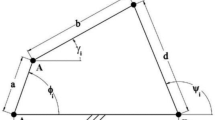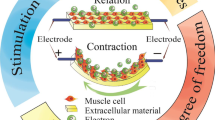Abstract
This paper presents the combined use of two systematic methods for the synthesis of planar linkage mechanisms satisfying multiple kinematic tasks. First, a Graph Theory-based method is used to exhaustively enumerate the topological alternatives for a given problem. Then each feasible alternative is automatically dimensioned using the Precision Position Method; this computation includes space and design constraints. The existing methods to synthesize multiple tasks solve, in sequence, a decomposition of the problem into single kinematic tasks. The task decomposition and the topology selection for each task are usually performed by hand. This process leads to topologies with a repeated pattern and could lead to ignoring potentially desirable topologies. This paper analyzes a design strategy for the simultaneous solution of multiple kinematic tasks. This strategy has two advantages: (i) it eliminates the need for task decomposition, and (ii) it allows the exhaustive exploration of all non-isomorphic topologies up to a defined number of links. An example of simultaneous synthesis for a double rigid-body guidance task with application to a flap-tab mechanism is shown to illustrate the methodology.













Similar content being viewed by others
Notes
Hereafter, the term “type” embraces both the type and the number synthesis stages of design.
Genetic algorithms are suitable for problems where neither domain nor goal function and restrictions are known; or they are so complicated that gradient computation becomes difficult or impossible [18]. Note that in this sizing problem, the system of (10) may not have a solution and it is difficult to compute the gradient of the space constraints.
References
Acharyya, S., Mandal, M.: Performance of eas for four-bar linkage synthesis. Mech. Mach. Theory 44(9), 1784–1794 (2009)
Avilés, R., Vallejo, J., Fernández de Bustos, I., Aguirrebeitia, J., Ajuria, G.: Optimum synthesis of planar linkages using a strain-energy error function under geometric constraints. Mech. Mach. Theory 45(1), 65–79 (2010)
Cabrera, J., Ortiz, A., Nadal, F., Castillo, J.: An evolutionary algorithm for path synthesis of mechanisms. Mech. Mach. Theory 46(2), 127–141 (2011)
Campanile, L.F.: Chapter 4: Lightweight shape-adaptable airfoils: A new challenge for an old dream. In: Wagg, D., Bond, I., Weaver, P., Friswell, M. (eds.) Adaptive Structures: Engineering Applications, pp. 89–135. Wiley, New York (2007)
Chen, C., Angeles, J.: A novel family of linkages for advanced motion synthesis. Mech. Mach. Theory 43(7), 882–890 (2008)
Collard, J.F., Duysinx, P., Fisette, P.: Optimal synthesis of planar mechanisms via an extensible-link approach. Struct. Multidiscip. Optim. 42, 403–415 (2010)
Cugnon, F., Cardona, A., Selvi, A., Paleczny, C., Pucheta, M.: Chapter: Synthesis and optimization of flexible mechanisms. In: Bottasso, C.L. (ed.) Multibody Dynamics, Computational Methods and Applications. Comp. Meth. in App. Sci., vol. 12, pp. 81–93. Springer, Amsterdam (2008)
Da Lio, M., Cossalter, V., Lot, R.: On the use of natural coordinates in optimal synthesis of mechanisms. Mech. Mach. Theory 35(10), 1367–1389 (2000)
Diab, N., Smaili, A.: Optimum exact/approximate point synthesis of planar mechanisms. Mech. Mach. Theory 43(12), 1610–1624 (2008)
Erdman, A.G., Sandor, G.: Mechanism Design: Analysis and Synthesis, 3rd edn., vol. 1, Prentice-Hall, New Jersey (1997)
Fang, W.E.: Simultaneous type and dimensional synthesis of mechanisms by genetic algorithms. In: Proc. of the 23rd Biennial Mechanisms Conference. Mechanism Synthesis and Analysis, vol. 70, pp. 35–41. ASME Design Engineering Division (1994)
Hansen, J.M.: Synthesis of mechanisms using time-varying dimensions. Multibody Syst. Dyn. 7(1), 127–144 (2002)
Hartenberg, R.S., Denavit, J.: Kinematic Synthesis of Linkages. McGraw-Hill, New York (1964)
Jensen, O., Hansen, J.: Dimensional synthesis of spatial mechanisms and the problem of non-assembly. Multibody Syst. Dyn. 15(2), 107–133 (2006)
Liu, Y., McPhee, J.: Automated kinematic synthesis of planar mechanisms with revolute joints. Mech. Based Des. Struct. Mach. 35(4), 405–445 (2007)
Luo, Z., Dai, J.: Chapter: Searching for undiscovered planar straight-line linkages. In: Lenarčič, J., Roth, B. (eds.) Advances in Robot Kinematics, Mechanisms and Motion, Part 2, pp. 113–122. Springer, Berlin (2006)
McCarthy, J.M., Soh, G.S.: Geometric Design of Linkages, 2 edn. Springer, Berlin (2010)
Michalewicz, Z.: Genetic Algorithms + Data Structures = Evolution Programs. Springer, New Jersey (1997)
Murray, A., Schmiedeler, J., Korte, B.: Synthesis of planar, shape-changing rigid-body mechanisms. J. Mech. Des. 130(3), 1–10 (2008)
Oliva, J.C., Goodman, E.D.: Simultaneous type and dimensional synthesis of planar 1DOF mechanisms using evolutionary search and convertible agents. ASME J. Mech. Robotics 2(3), 1–9 (2010)
Persinger, J., Schmiedeler, J., Murray, A.: Synthesis of planar rigid-body mechanisms approximating shape changes defined by closed curves. J. Mech. Des. 131(7), 1–7 (2009)
Peñuñuri, F., Peón-Escalante, R., Villanueva, C., Pech-Oy, D.: Synthesis of mechanisms for single and hybrid tasks using differential evolution. Mech. Mach. Theory 46(10), 1335–1349 (2011)
Pucheta, M.: Computational methods for design and synthesis of planar mechanisms. Ph.D. thesis, Universidad Nacional del Litoral, Santa Fe, Argentina (2008)
Pucheta, M., Cardona, A.: An automated method for type synthesis of planar linkages based on a constrained subgraph isomorphism detection. Multibody Syst. Dyn. 18(2), 233–258 (2007)
Pucheta, M., Cardona, A.: Synthesis of planar multi-loop linkages starting from existing parts or mechanisms: Enumeration and initial sizing. Mech. Based Des. Struct. Mach. 36(4), 364–391 (2008)
Pucheta, M.A., Cardona, A.: Automated type and modular dimensional synthesis of planar linkages. In: Proc. of ASME IDETC/CIE Conferences. Montreal, Quebec, Canada (2010). Paper DETC-28540
Pucheta, M.A., Cardona, A.: Design of bistable compliant mechanisms using precision-position and rigid-body replacement methods. Mech. Mach. Theory 45(2), 304–326 (2010)
Raghavan, M.: Number and dimensional synthesis of independent suspension mechanisms. Mech. Mach. Theory 31(8), 1141–1153 (1996)
Sancibrian, R.: Improved GRG method for the optimal synthesis of linkages in function generation problems. Mech. Mach. Theory 46(10), 1350–1375 (2011)
Sandor, G., Erdman, A.G.: Advanced Mechanism Design: Analysis and Synthesis, vol. 2. Prentice-Hall, New Jersey (1984)
Sardain, P.: Linkage synthesis: Topology selection fixed by dimensional constraints, study of an example. Mech. Mach. Theory 32(1), 91–102 (1997)
Schreiber, H., Meer, K., Schmitt, B.J.: Dimensional synthesis of planar Stephenson mechanisms for motion generation using circlepoint search and homotopy methods. Mech. Mach. Theory 37(7), 717–737 (2002)
Shen, Q., Al-Smadi, Y.M., Martin, P., Russell, K., Sodhi, R.: An extension of mechanism design optimization for motion generation. Mech. Mach. Theory 44(9), 1759–1767 (2009)
Smaili, A., Diab, N.: Optimum synthesis of hybrid-task mechanisms using ant-gradient search method. Mech. Mach. Theory 42(1), 115–130 (2007)
Tsai, L.: Mechanism Design: Enumeration of Kinematic Structures According to Function. CRC Press, Boca Raton (2001)
Vucina, D., Freudenstein, F.: An application of graph theory and nonlinear programming to the kinematic synthesis of mechanisms. Mech. Mach. Theory 26, 553–563 (1991)
Wu, L.C., Carbone, G., Ceccarelli, M.: Designing an underactuated mechanism for a 1 active DOF finger operation. Mech. Mach. Theory 44(2), 336–348 (2009)
Acknowledgements
This work has received financial support from the following Argentinean institutions: Consejo Nacional de Investigaciones Científicas y Técnicas PIP2009 112-200801-02473, Agencia Nacional de Promoción Científica y Tecnológica PICT-2010-1240, and Universidad Nacional del Litoral CAI+D 2009 PI65-330.
Author information
Authors and Affiliations
Corresponding author
Rights and permissions
About this article
Cite this article
Pucheta, M.A., Cardona, A. Topological and dimensional synthesis of planar linkages for multiple kinematic tasks. Multibody Syst Dyn 29, 189–211 (2013). https://doi.org/10.1007/s11044-011-9294-3
Received:
Accepted:
Published:
Issue Date:
DOI: https://doi.org/10.1007/s11044-011-9294-3




